Central Bank Watch Overview:
- At the start of 2022, central banks appear ready to move aggressively on rate hikes – at least three rate hikes are expected by each of the central banks in this report.
- The most hawkish of the central banks in this report, the Reserve Bank of New Zealand, is still expected to hike rates at six of seven meetings in 2022.
- Retail trader positioning suggests that the Australian Dollar has a bullish bias while the Canadian and New Zealand Dollars have a mixed bias.
Omicron Concerns Fade
In this edition of Central Bank Watch, we’re examining the rates markets around the Bank of Canada, Reserve Bank of Australia, and Reserve Bank of New Zealand. While the COVID-19 omicron variant continues to push infection totals to pandemic highs, the economic fallout has been limited thus far, and doesn’t appear like it will materialize too significantly. Accordingly, rates markets are optimistic that central banks will move aggressively to tamp down stimulus efforts throughout 2022; each of the Bank of Canada, Reserve Bank of Australia, and Reserve Bank of New Zealand are expected to hike rates at least three times this year.
For more information on central banks, please visit the DailyFX Central Bank Release Calendar.

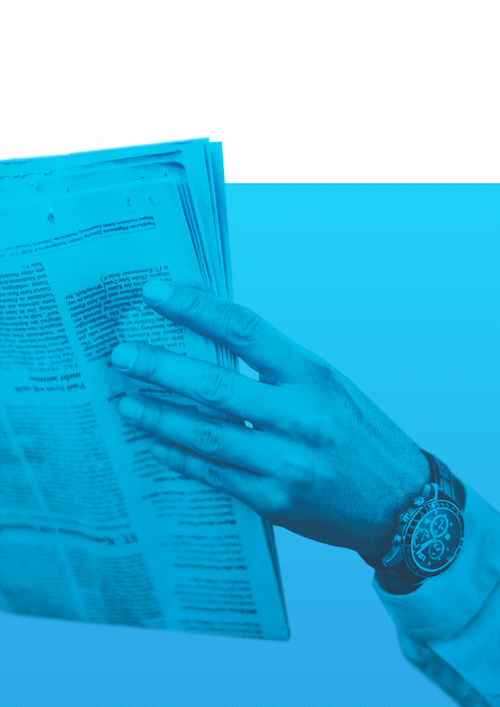

BOC Meets Later This Month
The Bank of Canada has yet to meet in 2022, but will do so later this month. By that time, more information about the COVID-19 omicron variant and its impact on the global economy will be known, but thus far, the fallout seems limited. Accordingly, the BOC is likely to be emboldened in its thought process outlined last month, when policymakers more or less downplayed the impact of omicron on the path of interest rates in 2022. Rates markets have taken notice and have taken a more aggressive stance in recent weeks.
Bank of Canada Interest Rate Expectations (January 5, 2022) (Table 1)

In mid-December, Canada overnight swaps were pricing in a 50% chance of the first 25-bps rate hike arriving in March 2022. The limited impact of omicron plus the surge in oil prices – energy accounts for approximately 11% of Canadian GDP – has seen traders boost their bets that the BOC will act more aggressively in the first half of 2022. There is now a 102% chance of a 25-bps rate hike in March (100% chance of a 25-bps rate hike plus a 2% chance of a 50-bps rate hike), while the second 25-bps hike is likely to arrive in April (84% chance) and a third 25-bps hike is discounted for June (62% chance).
IG Client Sentiment Index: USD/CAD Rate Forecast (January 5, 2022) (Chart 1)
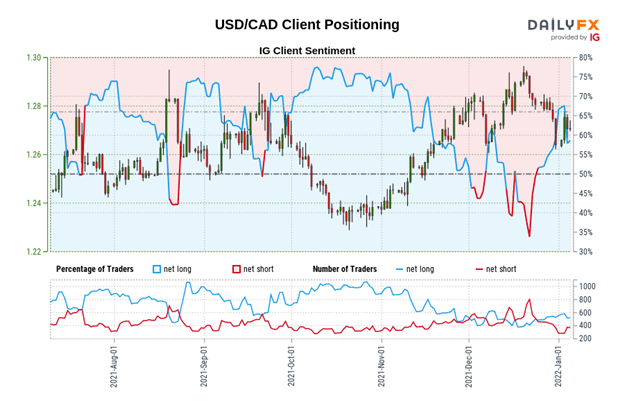
USD/CAD: Retail trader data shows 54.35% of traders are net-long with the ratio of traders long to short at 1.19 to 1. The number of traders net-long is 5.36% higher than yesterday and 4.50% lower from last week, while the number of traders net-short is 1.83% higher than yesterday and 4.21% higher from last week.
We typically take a contrarian view to crowd sentiment, and the fact traders are net-long suggests USD/CAD prices may continue to fall.
Positioning is more net-long than yesterday but less net-long from last week. The combination of current sentiment and recent changes gives us a further mixed USD/CAD trading bias.
RBA Looking Past Lockdowns, Omicron
The Reserve Bank of Australia has been mostly quiet at the start of the year, although the release of the Chart Pack offers the first insight into how policymakers believe the economy will evolve over the coming months. Inflation pressures and expectations remain elevated, and a rebounding labor market is expected to help keep growth tilted higher for the foreseeable future. It’s worth noting that Australian economic data has been steadily improving in recent months, so much so that the current Australian unemployment rate of 4.6% is quickly approaching the RBA’s 2022 year-end forecast of 4.2%. These factors point to an aggressive RBA this year.



RESERVE BANK OF AUSTRALIA INTEREST RATE EXPECTATIONS (January 5, 2022) (TABLE 2)
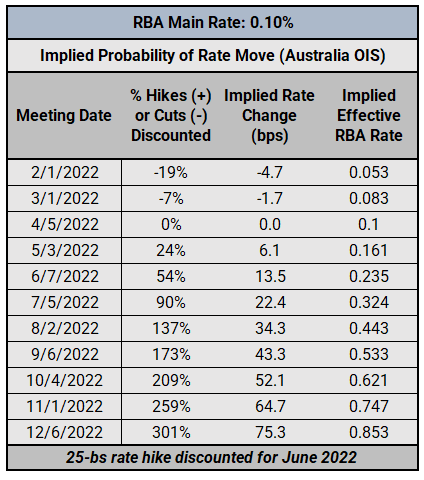
RBA rate hike odds for 2022 have been steady in recent weeks, with the odds of the first 25-bps rate hike at 54% -- basically where they were at the start of December, when Australia overnight index swaps were pricing in a 55% chance. But the market has pulled forward an additional rate hike into 2022, with the second rate hike expected in September (73% chance) and a third rate hike anticipated in November (59% chance).
IG Client Sentiment Index: AUD/USD Rate Forecast (JANUARY 5, 2022) (Chart 2)
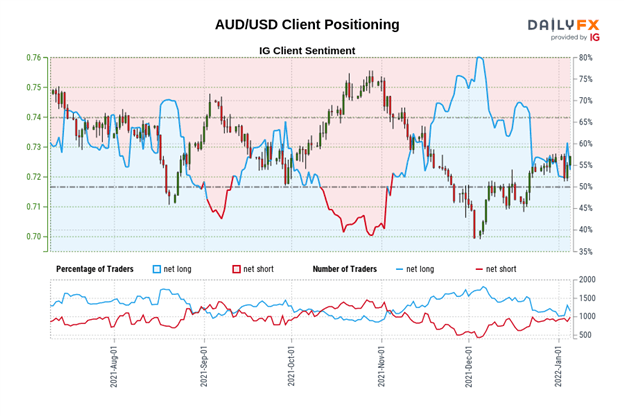
AUD/USD: Retail trader data shows 54.11% of traders are net-long with the ratio of traders long to short at 1.18 to 1. The number of traders net-long is 0.97% lower than yesterday and 0.82% higher from last week, while the number of traders net-short is 8.68% higher than yesterday and 11.96% higher from last week.
We typically take a contrarian view to crowd sentiment, and the fact traders are net-long suggests AUD/USD prices may continue to fall.
Yet traders are less net-long than yesterday and compared with last week. Recent changes in sentiment warn that the current AUD/USD price trend may soon reverse higher despite the fact traders remain net-long.



RBNZ Has Most Aggressive Expectations
Unlike other major central banks, the Reserve Bank of New Zealand’s policy remit includes house price growth as a key factor (besides inflation and employment). The latest round of housing data came in exceptionally hot, underscoring the possibility that the RBNZ will move aggressively over the course of 2022. House prices increased by +27.6% in 2021, the fastest year-over-year increase since 2003 when house prices gained +24.4%. Nevertheless, there is a lot of room for disappointment if the RBNZ doesn’t meet expectations for what would still be the quickest pace of rate hikes by any major central bank in the post-Global Financial Crisis era.
RESERVE BANK OF NEW ZEALAND INTEREST RATE EXPECTATIONS (JANUARY 5, 2022) (Table 3)

Rates markets are still discounting a 100% chance of a 25-bps rate hike at the February RBNZ meeting, with a 12% chance of a 50-bps hike, down from a 20% chance of a 50-bps hike in mid-December. The RBNZ is expected to raise rates at six of its seven meetings in 2022. Considering that this has already been discounted by rates markets, tur point of view remains that “it may be the case that RBNZ rate hike pricing is an albatross around the Kiwi’s neck for the foreseeable future.”



IG Client Sentiment Index: NZD/USD Rate Forecast (JANUARY 5, 2022) (Chart 3)
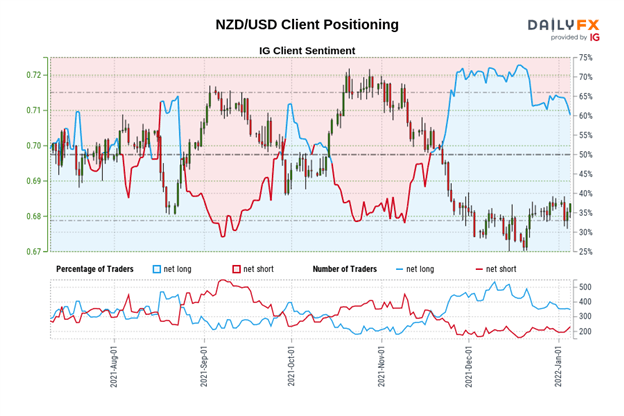
NZD/USD: Retail trader data shows 61.38% of traders are net-long with the ratio of traders long to short at 1.59 to 1. The number of traders net-long is 3.70% higher than yesterday and 7.38% lower from last week, while the number of traders net-short is 7.66% lower than yesterday and 3.62% higher from last week.
We typically take a contrarian view to crowd sentiment, and the fact traders are net-long suggests NZD/USD prices may continue to fall.
Positioning is more net-long than yesterday but less net-long from last week. The combination of current sentiment and recent changes gives us a further mixed NZD/USD trading bias.
--- Written by Christopher Vecchio, CFA, Senior Strategist





